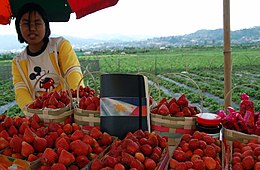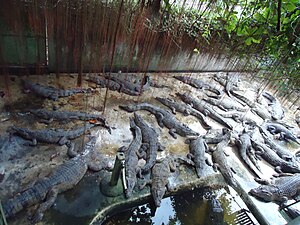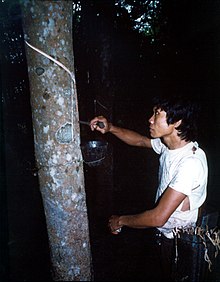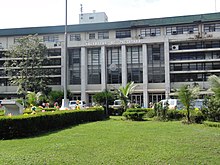Agriculture in the Philippines
[5] In 2022, the country's chief economist Arsenio Balisacan said that Philippine agriculture was in crisis, citing such issues as the high price of meat and rice and low profitability for farmers.
[15] Many of the Philippines' farmers operate small-sized farms which have been granted to them as a result of several decades of land reform programs.
[16] Economists such as Bernardo M. Villegas have cited the potential of interventions such as Farmers' Cooperatives which would allow smallholder farms to achieve the economies of scale needed to become more economically viable.
[16] Many Filipino farmers live in poverty due to a combination of factors, including economic policy, environmental, and land ownership issues.
[21] The primary role of agriculturists is to provide services for crop, livestock, and poultry production, processing, and distribution in both urban and rural areas that include the following: A prospective professional agriculturist is typically required to have a four-year Bachelor of Science degree in Agriculture, although other degree programs directly related to agriculture are also allowed to take the licensure examination if they earn at least eighteen (18) units of agriculture credits from a recognized higher education institution.
[34] However, in April 2023, the Supreme Court of the Philippines issued a Writ of Kalikasan ordering the Department of Agriculture to stop the commercial distribution of genetically modified rice and eggplants in the country.
[40] The Philippines is one of the few countries that produce the four main viable coffee varieties; Arabica, Liberica (Barako), Excelsa and Robusta.
[46] There are 3.5 million hectares dedicated to coconut production in the Philippines, which accounts for 25 percent of total agricultural land in the country.
Historically, the Southern Tagalog and Bicol regions of Luzon and the Eastern Visayas were the centers of coconut production.
[50] Mangoes are the third most important fruit crop of the country based on export volume and value next to bananas and pineapples.
[52] It is estimated that as of 2012[update], the industry provides direct employment to 700,000 sugarcane workers spread across 19 sugar producing provinces.
[54] Aquaculture in the Philippines (which includes fish, shellfish, and seaweed farming) comprises 39% of the country's fisheries sector.
Around 42 percent of the total abaca fiber shipments from the Philippines went to the United Kingdom in 2014, making it the top importer.
Farmers and environmentalists have held demonstrations and filed court petitions protesting the promotion, cultivation, and sale of genetically modified products in the Philippines.
Some agricultural practices, including export crops and encroachment by small farmers, lead to deforestation.
[72] Agriculture is one of the Philippines' largest sectors and will continue to be adversely impacted by the effects of climate change.
[73] The two most important crops, rice and corn, account for 67% of the land under cultivation and stand to see reduced yields from heat and water stress.
[73] In addition to these challenges, the agricultural sector in the Philippines has also been significantly impacted by the drought conditions induced by El Niño.
[74] Rice, wheat, and corn crops are expected to see a 10% decrease in yield for every 1 °C increase over a 30 °C average annual temperature.
[75] Rising sea levels increases salinity which leads to a loss of arable land and irrigation water.
[75] Agricultural areas are being subjected to land conversion to make way for development projects, to the detriment of farmers' welfare and the country's food security.
[77] According to former Department of Agriculture secretary Florencio Abad, farmlands are also being converted for non-agricultural purposes, such as for housing subdivisions, shopping centers, golf courses or recreation camps, export processing zones, and mining exploration.
[78] Massive land use conversion occurring in the country harms the agricultural sector in general and has negative effects on food security and rice supply.
It also leads to higher prices for basic commodities and worsens the country's dependence on agricultural imports.
These include exposure to harmful pesticides and chemical fertilizers, physical injuries, and long work hours, according to the International Labour Organization.












